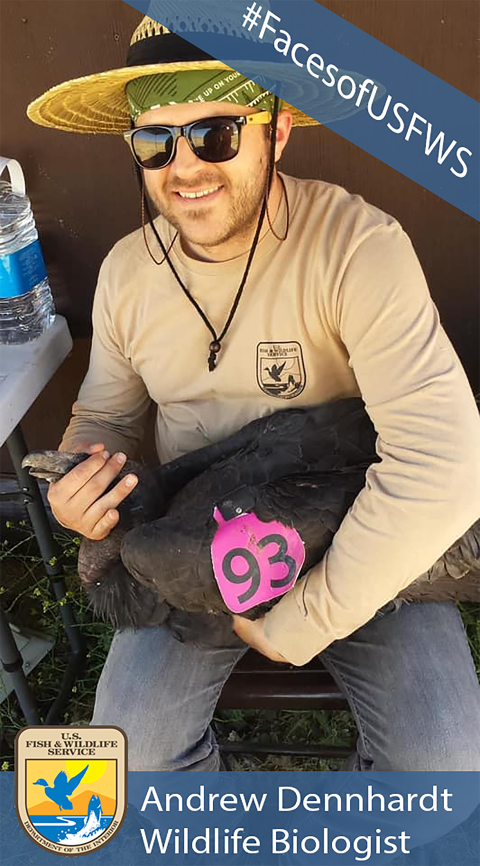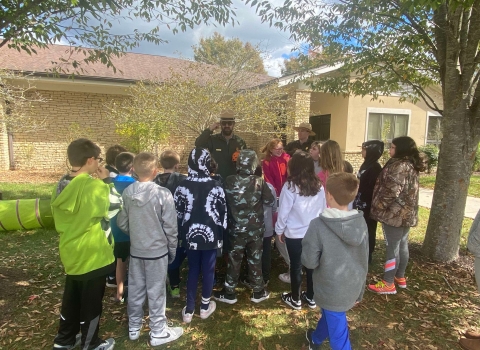By Olivia Beitelspacher, public affairs specialist
Meet fish and wildlife biologist Andrew Dennhardt! Andrew discusses his conservation heroes and his path to the U.S. Fish and Wildlife Service. Learn more about Andrew in the latest Faces of the U.S. Fish and Wildlife Service interview.
Olivia Beitelspacher:Welcome to the U.S. Fish and Wildlife Service Andrew! Can you describe the role you play within the agency?
Andrew Dennhardt: I am a newly hired fish and wildlife biologist in the Listing and Recovery division of our Ecological Services office in Ventura, and my roles include drafting status reviews and assessments for federally threatened and endangered species as well as implementing conservation activities to advance their recovery. I am currently tasked with co-leading recovery efforts for the Santa Barbara County distinct population segment of the California tiger salamander (Ambystoma californiense), Arroyo toad (Anaxyrus californicus), and least Bell's vireo (Vireo bellii pusillus).
OB: You’re certainly doing some important work! So tell us, what led you to a career with the U.S. Fish and Wildlife Service?
AD: Today, the answer to this question stems immediately from my Directorate Resource Assistants Fellowship Program (DFP) internship in 2019, which was an exceptional experience. Historically, the answer stems gradually from my lifelong passion for people, research, education, and wildlife conservation. Growing up with self-proclaimed land stewards as parents on an organic produce farm, our family visited many conservation festivals together, and a celebration called “Bald Eagle Days” first introduced me to local agents of the Service as well as to their daily work with (and passions for) wildlife. Early on, I knew that I wanted to explore working for the Service in the future, and I was provided the opportunity to do so during my DFP internship in summer 2019. While studying past, present, and future recovery of least Bell’s vireo in that role, I also found an organization to call my home away from home in the Ventura Fish and Wildlife Office, and it was the hard work and passion of our biologists that readily brought me back for permanent employment with the Service. I am so thankful for this new opportunity, and I am also honored to be a U.S. Fish and Wildlife Service biologist—particularly after achieving this goal with the help of many generous mentors along the way.
OB: Wow, what a journey! The DFP internship is a fantastic way for students to learn more about conservation and establish a connection with the U.S. Fish and Wildlife Service . And it’s so cool that you get to come back to the office where you completed your DFP! So, Andrew, where did you go to school and what did you study?
AD: I received my bachelor’s degree in zoology, with a minor in environmental studies, from Southern Illinois University in Carbondale, during which I researched natal dispersal habits of peregrine falcons in the midwestern U.S. Later, I received my master’s degree in wildlife and fisheries resources from West Virginia University in Morgantown, during which I studied the migration and population ecology of golden eagles in eastern North America. Recently, I completed my dual doctorate in fisheries and wildlife as well as ecology, evolutionary biology, and behavior at Michigan State University in East Lansing, during which I evaluated multi-species fish and bird population responses to environmental and anthropogenic factors across the Great Lakes region and continental North America. To learn more about my education and research, please visit my personal website at https://andrewjdennhardt.weebly.com/.
OB: Congratulations on your recent graduation! Do you have any conservation heroes?
AD: My conservation heroine is Rachel Carson, and my conservation hero is Aldo Leopold because each of them was an excellent communicator during their time. Leopold’s A Sand County Almanac is one of my favorite books, especially because many of its stories remind me of my childhood while growing up on a small farm in the Midwest. Carson’s Silent Spring is also near and dear to me because, in addition to another great book, I also learned that preliminary research on birds conducted at my alma mater, Michigan State University, helped form the basis of Carson’s rallying cry for conservation action against the widespread use of pollutants like DDT in the United States and elsewhere. It is Leopold’s and Carson’s abilities to communicate well, so captivatingly, that regularly inspire me to be a better communicator, especially in my new role as a Service biologist. Of Carson: “Those who dwell, as scientists or laymen, among the beauties and mysteries of the earth, are never alone or weary of life,” and of Leopold: “When we see land as a community to which we belong, we may begin to use it with love and respect.” Well said, the both of you.
OB: Rachel Carson and Aldo Leopold are two of my conservation heroes as well. It’s amazing that their work and dedication continue to inspire so many generations of conservation stewards! Is there a particular project from your career or schooling that makes you really proud?
AD: My master’s research was quite the challenge in its day. For the first time in my education, I was asked to code computer programs, particularly those that would predict the migration patterns of a rare soaring raptor in response to updrafts in the environment. Raising the stakes, I was also tasked with collating historic records on sightings of these rare birds across a large geographic region, over many years, to later integrate with outputs from my migration simulations. Together, these data would be used to generate population abundance estimates for golden eagles in the study region, and with the help of several mentors and collaborators, I found a way to make our ambitious goals become realized. After later witnessing the scientific community challenge, distribute, and then adapt my work for use in other geographic regions, I have never felt so proud of a personal accomplishment before. Later, population estimates from this work informed guidance documents for conserving golden eagles across North America—guidance documents drafted by fellow colleagues of the Service in the Migratory Birds program Birds. To see my research inform management decisions, that was certainly a peak achievement of my early career, and I will always cherish such moments in my memory.
OB: That definitely sounds like an ambitious and challenging project! I’m glad to hear you’re your hard work paid off and is still informing management decisions! When you’re not out working hard in the field, how do you like to spend your free time?
AD: In my free time, I enjoy participating in sports like hunting, fishing, hiking, football, biking, volleyball, ultimate frisbee, softball, and basketball. Given my love of raptors and other birds, I also like to get out and observe our feathered friends from time to time, especially with my spouse, Amanda. We also enjoy traveling to new wild places together, including our national wildlife refuges, forests, and parks. On rarer occasions, we like to hit the town and sing some karaoke as well. And at great risk of attracting surprise weekend visitors or catering orders, occasionally, I also like to barbecue various meats with my smoker at home.
OB: That’s quite the list! I’m sure your days are never boring! Lastly, do you have a hidden talent? If so, what is it?
AD: I am not ashamed to admit that I like to impersonate animal sounds and sometimes other people’s voices, especially those of friends and family. I also like to think that I am pretty good at it, depending on who or what is the subject of my flattering imitations. Perhaps the best proof of my skills in this area is that several years ago, I was told by my supervisors at the time that one of the main reasons they had hired me for one of the technician positions at our consulting company was because a reference from the U.S. Forest Service had told them that I was “an excellent replicator of owl calls.” Needless to say, I had a real hoot that summer surveying the California Redwood Coast for northern spotted owls, and I often did not use the electronic callers to help locate them. I never thought that I would ever earn a job with my imitation skills, but those were the good ol’ days, reminders of a much simpler time since fewer computer models and video conferences were involved back then.
OB: Wow, that’s super impressive! I’m looking forward to hearing your impersonations. Thanks Andrew!


